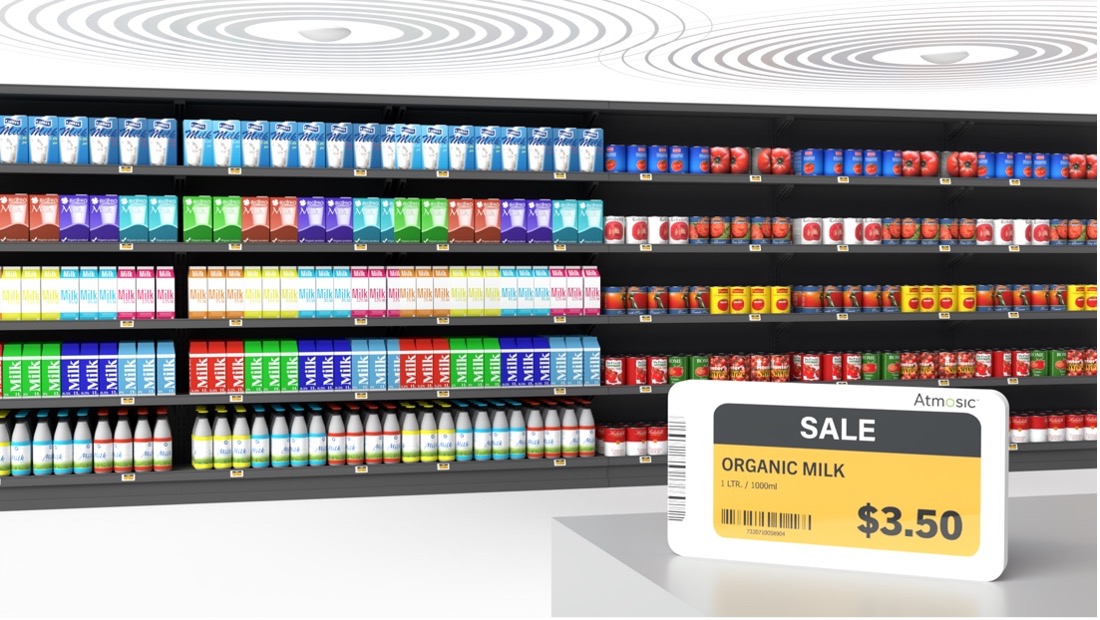Applications
Retail & Electronic Shelf Labels (ESL)
Retail & Electronic Shelf Labels (ESL)
Retail stores worldwide are strong adopters of IoT technology with consumers witnessing the incorporation of loyalty schemes and the change from paper-based shelf labels to remotely controlled Electronic Shelf Labels (ESL).
Electronic Shelf Labels bring massive benefits to retail establishments by enabling greater efficiency and accuracy in the deployment of price and product changes. ESLs also allow retail establishments to offer promotions on individual products while back-end systems monitor their effectiveness.
ESL technology can however create new problems if labels need frequent battery maintenance. Atmosic SoC's with their industry-leading low power consumption and integrated energy harvesting technology is an effective option to minimize battery consumption and maintenance costs.
In 2021, with a 32% CAGR year/year growth another 120 Million ESLs were added to grocery stores and other commercial facilities.
As of 2021, there were over 600 Million Electronic Shelf Labels adding to the in-store consumer experience.
“Atmosic’s ultra-low power ATM2 SoC solution makes ESL products more robust in terms of interactivity and speed, in addition to removing the need for battery replacement. Atmosic’s technology is also easy to integrate into a range of ESL sizes and designs.” said Mr. Xia, CEO of ETAG Tech
HARDWARE
Please visit the ATM product pages to learn more about the Atmosic SoCs and the ESL evaluation kit available to start developing today.
Contact Atmosic for more information about accessing our reference designs and documentation.
SOFTWARE
The ESL application is one of the many examples provided in the Atmosic software development kit (SDK). The SDK enables customers to develop and customize their product across the different Atmosic SoC platforms.
Contact Atmosic for access to our SDK.
What are Electronic Shelf Labels?
Electronic Shelf Labels are small displays that present product and pricing information in retail establishments. ESLs designs are powered by a variety of options with developers selecting wired, battery, and harvested options. They are designed for remote management and often employ a number of wireless technologies including Bluetooth, InfraRed, or proprietary radio solutions
Customer Loyalty
The customer experience is vital to the continued relationship with a retail facility and its customer base. Electronic shelf labels offer customers direct product and pricing information, but when used together with customer loyalty programs can be used to drive increased revenue.
ESLs can be used to deliver just-in-time notifications to individual customers through beacons and display updates or used to steer a customer to specific product shelves when used in location systems together with mobile apps.
Remote Management
Pricing is not only a critical part of the customer experience but it is also a challenge for the operations team chartered with maintaining it.
Paper labels are subject to errors and require teams of individuals to keep up to date - such an approach is compounded if store-wide (eg. such as in the event of a tax change)
ESLs allow retail chain to centrally manage their pricing and make instant changes across all of their outlets with less potential for error.
Inventory Control
Electronic shelf labels can also provide retail establishments with insight as to the quantities of products available on the shelf. The same ESL devices can also be used to highlight to the consumer where any additional stock may exist within the facility (such as on aisle end caps).
Low stock levels can be reported to floor managers to prioritize stock replenishment over low-value tasks if needed.
Why Bluetooth?
Bluetooth has become the solution for most new designs as enables a number of features that help retailers grow the capabilities of their customer loyalty programs.
Bluetooth is a standard and as such drives easier integration with existing ecosystems.
- Bluetooth's real-time location capabilities such as AoA and AoD can be used to direct customers to specific shelves within a store.
- Mobile phones natively support Bluetooth and can leverage beacon technology for 'just-in-time' notifications
- Bluetooth is used by the AirFuel wireless power protocol that allows ESL to be powered or charged without the need for batteries reducing most if not all maintenance overhead.
- Most retail establishments have already installed Wi-Fi access points most of which also support Bluetooth
- As a standard developers benefit from using a multi-vendor truly global standard backed by a product qualification program that guaranteed interoperability with devices, infrastructure, and mobile phones, whilst also providing lower development costs

